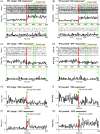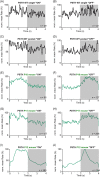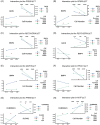Human-Induced Pluripotent Stem Cells Generate Light Responsive Retinal Organoids with Variable and Nutrient-Dependent Efficiency
- PMID: 30004612
- PMCID: PMC6392112
- DOI: 10.1002/stem.2883
Human-Induced Pluripotent Stem Cells Generate Light Responsive Retinal Organoids with Variable and Nutrient-Dependent Efficiency
Abstract
The availability of in vitro models of the human retina in which to perform pharmacological and toxicological studies is an urgent and unmet need. An essential step for developing in vitro models of human retina is the ability to generate laminated, physiologically functional, and light-responsive retinal organoids from renewable and patient specific sources. We investigated five different human-induced pluripotent stem cell (iPSC) lines and showed a significant variability in their efficiency to generate retinal organoids. Despite this variability, by month 5 of differentiation, all iPSC-derived retinal organoids were able to generate light responses, albeit immature, comparable to the earliest light responses recorded from the neonatal mouse retina, close to the period of eye opening. All iPSC-derived retinal organoids exhibited at this time a well-formed outer nuclear like layer containing photoreceptors with inner segments, connecting cilium, and outer like segments. The differentiation process was highly dependent on seeding cell density and nutrient availability determined by factorial experimental design. We adopted the differentiation protocol to a multiwell plate format, which enhanced generation of retinal organoids with retinal-pigmented epithelium (RPE) and improved ganglion cell development and the response to physiological stimuli. We tested the response of iPSC-derived retinal organoids to Moxifloxacin and showed that similarly to in vivo adult mouse retina, the primary affected cell types were photoreceptors. Together our data indicate that light responsive retinal organoids derived from carefully selected and differentiation efficient iPSC lines can be generated at the scale needed for pharmacology and drug screening purposes. Stem Cells 2018;36:1535-1551.
Keywords: Retina; Retinal photoreceptors; Stem cells; iPS.
© 2018 The Authors Stem Cells published by Wiley Periodicals, Inc. on behalf of AlphaMed Press.
Conflict of interest statement
M.U. declared employment with Novartis Pharma AG. S.K. declared employment with F. Hoffmann‐La Roche Ltd. D.S. declared advisory role with Alcon and research funding from Bayer. M.N. declared employment and stock ownership with Newcells Biotech Ltd. The other authors indicated no potential conflict of interest.
Figures







Similar articles
-
Systematic Comparison of Retinal Organoid Differentiation from Human Pluripotent Stem Cells Reveals Stage Specific, Cell Line, and Methodological Differences.Stem Cells Transl Med. 2019 Jul;8(7):694-706. doi: 10.1002/sctm.18-0267. Epub 2019 Mar 27. Stem Cells Transl Med. 2019. PMID: 30916455 Free PMC article.
-
Human iPSC-Derived Retinas Recapitulate the Fetal CRB1 CRB2 Complex Formation and Demonstrate that Photoreceptors and Müller Glia Are Targets of AAV5.Stem Cell Reports. 2019 May 14;12(5):906-919. doi: 10.1016/j.stemcr.2019.03.002. Epub 2019 Apr 4. Stem Cell Reports. 2019. PMID: 30956116 Free PMC article.
-
Robust generation of photoreceptor-dominant retinal organoids from porcine induced pluripotent stem cells.Stem Cell Reports. 2025 Apr 8;20(4):102425. doi: 10.1016/j.stemcr.2025.102425. Epub 2025 Mar 6. Stem Cell Reports. 2025. PMID: 40054472 Free PMC article.
-
Inducible Pluripotent Stem Cells to Model and Treat Inherited Degenerative Diseases of the Outer Retina: 3D-Organoids Limitations and Bioengineering Solutions.Cells. 2021 Sep 20;10(9):2489. doi: 10.3390/cells10092489. Cells. 2021. PMID: 34572137 Free PMC article. Review.
-
New Drug Discovery Paradigms for Retinal Diseases: A Focus on Retinal Organoids.J Ocul Pharmacol Ther. 2020 Jan/Feb;36(1):18-24. doi: 10.1089/jop.2018.0140. Epub 2019 May 6. J Ocul Pharmacol Ther. 2020. PMID: 31059378 Free PMC article. Review.
Cited by
-
Advances in Regeneration of Retinal Ganglion Cells and Optic Nerves.Int J Mol Sci. 2021 Apr 28;22(9):4616. doi: 10.3390/ijms22094616. Int J Mol Sci. 2021. PMID: 33924833 Free PMC article. Review.
-
A Review of Gene, Drug and Cell-Based Therapies for Usher Syndrome.Front Cell Neurosci. 2020 Jul 9;14:183. doi: 10.3389/fncel.2020.00183. eCollection 2020. Front Cell Neurosci. 2020. PMID: 32733204 Free PMC article.
-
Semi-Automated Approach for Retinal Tissue Differentiation.Transl Vis Sci Technol. 2020 Sep 23;9(10):24. doi: 10.1167/tvst.9.10.24. eCollection 2020 Sep. Transl Vis Sci Technol. 2020. PMID: 33024617 Free PMC article.
-
Organoid Technology: A Reliable Developmental Biology Tool for Organ-Specific Nanotoxicity Evaluation.Front Cell Dev Biol. 2021 Sep 23;9:696668. doi: 10.3389/fcell.2021.696668. eCollection 2021. Front Cell Dev Biol. 2021. PMID: 34631696 Free PMC article. Review.
-
Generation and Staging of Human Retinal Organoids Based on Self-Formed Ectodermal Autonomous Multi-Zone System.Front Cell Dev Biol. 2021 Sep 22;9:732382. doi: 10.3389/fcell.2021.732382. eCollection 2021. Front Cell Dev Biol. 2021. PMID: 34631711 Free PMC article.
References
-
- Stevens GA, White RA, Flaxman SR et al. Global Prevalence of Vision Impairment and Blindness Magnitude and Temporal Trends, 1990‐2010. Ophthalmology 2013;120:2377–2384. - PubMed
-
- Bourne RRA, Flaxman SR, Braithwaite T et al. Magnitude, temporal trends, and projections of the global prevalence of blindness and distance and near vision impairment: A systematic review and meta‐analysis. Lancet Glob Health 2017;5:e888–e897. - PubMed
-
- Ogilvie JM, Speck JD, Lett JM et al. A reliable method for organ culture of neonatal mouse retina with long‐term survival. J Neurosci Methods 1999;87:57–65. - PubMed
Publication types
MeSH terms
Substances
Grants and funding
LinkOut - more resources
Full Text Sources
Other Literature Sources

